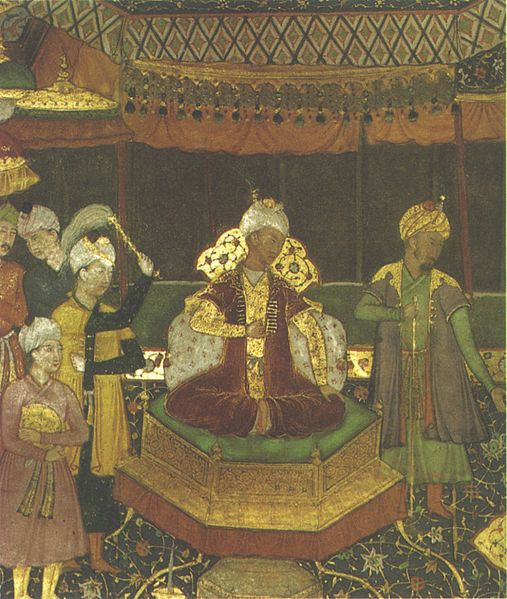- HubPages»
- Education and Science»
- History & Archaeology»
- History of Asia
The Mughal Empire In India
Symbol Of An Empire

The First Emperor

Background
The great subcontinent of India is a land that has been conquered many times down the centuries. The main reason for this, is while it has a very formidable natural barrier in the Himalayas which protects it from the north, it is and has always been vulnerable to invasions and raids from the northwest, from the direction of Central Asia. By the 11th century India was subject to regular raids from the armies of the Ghaznavid Empire. Two hundred years later Genghis Khan’s Mongol hordes swept through like a storm. Then, at the end of the 14th century it was the turn of one of another great Mongol conqueror and descendant of Genghis Khan, Timur Lenk who successfully besieged the city of Delhi in 1398, sacking it in the aftermath.
The next great chapter in India’s illustrious history began in 1494, when another descendent of Genghis Khan (and Timur Lenk), a 12 year old boy called Babur was forced out of his home in the city of Samarkand by the Uzbeks. Just three years later he returned, attempting to recapture the city through besiegement, but ultimately met with little success. Undeterred, Babur led his warband into Afghanistan, capturing the capital Kabul in 1504, making it his base for forays into the central Asian region of Transoxania. Towards the east the wealth of India beckoned. He made a series of invasions into Punjab and was soon asked by the local nobles to assist them in overthrowing Ibrahim Lodhi’s fearsome Afghan regime.
Before he did so though. Babur took the time to furnish his army with new gunpowder weapons and train them in how to use them properly. At the same time however, he was keen to preserve the more traditional skills of steppe warfare handed down from Genghis Khan. It wasn’t until the end of 1525, that Babur decided to launch a full scale invasion of Hindustan.
The Battle Of Panipat

More On The Battle Of Panipat
- First battle of Panipat, 21 April 1526
Another recommended link that goes into great detail about the battle. - First Battle of Panipat
A detailed and clear analysis of the Battle of Panipat.
Victory At Panipat
Babur’s army numbered only 10,000 but it still managed to brush aside the Afghan force sent to intercept it. On the 12th April 1526, Sultan Ibrahim, with 100,000 men and 1000 elephants, confronted the invaders at Panipat, north of Delhi. Babur though, was unperturbed and resolved to build an impromptu fortress on the open plain, lashing 700 carts together, with earthen ramparts, to safeguard his cannon and new matchlocks. He also dug trenches and felled trees to create barriers to the left and right, so as to leave gaps for his cavalry to filter through and charge. On the 21st April, Ibrahim attacked in earnest, but his soldiers came up short against Babur’s impressive and well placed fortifications. As the Mughal cavalry approached from the wings to encircle the enemy, the bombardment began from behind the barrier. Babur’s unleashed a hail of fire at point blank range into the closely packed masses of men. The Afghans were unable to either advance or retreat, so they were simply pulverised; almost 16,000 soldiers fell at Panipat. Many were killed through being trampled by their own elephants. Ibrahim had been killed during the course of the battle, leaving Babur free to claim lordship over Hindustan.
After the battle he moved quickly to occupy the cities of Delhi and Agra. However, despite arriving as a conquering overlord, Babur was to prove a rather fair, humanitarian and civilised ruler, as indeed were most of his successors. He helped a forge a successful template that would serve the Mughal Empire well in the coming centuries, a template built on the use of modern firepower and sophisticated field fortifications combined with the traditional mounted archers of the steppe.
A Highly Recommended Link
- Battle for Chitor: Storming the Last Hindu Fortress in 1567
More on the Battle of Chitor, which saw the fall of the last great Hindu fortress.
India In 1700

A Short Documentary About Aurangzeb
Shaping The Empire
The Muslim Mughals are famed for their religious tolerance and their openness to India’s aesthetic values. Babur’s grandson, Akbar the Great, ascended the throne in 1556, allying himself with northwest India’s Hindu princes, the Rajputs. The new emperor soon adopted Indian ways of waging war; from armoured elephants to the bagh nakh, or ‘tiger claw,‘ which was a sequence of razor sharp blades fitted to a haft or gauntlet, making them ideal weapons for slashing at close quarters. Rajput nobles were recruited into the Mughal army, along with their peasant troops. All in all the Mughals were able to mobilise an extra half a million warriors.
Akbar the Great spent virtually all of his reign as emperor at war. During the 1560s and 70s he asserted his power over his so called Rajput allies. These bold, if not aggressive moves were accepted by the Rajputs since Akbar gave them privileged offices of state. Anyone that resisted however, was dealt with brutally by force. A prime example of this occurred in 1568 when the last great Hindu fortress at Chitor was besieged and captured by the Mughals. A Mughal poet wrote the following words in the aftermath of the siege: ’What a great day it was for the vultures and the crows.’ Simultaneously, Akbar proceeded to invade the country’s eastern states, including Orissa and Bengal, extending the empire across the whole of northern India. During this period Kabul was taken by Babur’s old nemesis, the Uzbeks, under their formidable leader And Allah Khan. However, Khan’s death in 1598 signalled an end to the Uzbek threat, and security to the northwest. Akbar soon established a new frontier on the banks of India’s Godavari River.
Under subsequent Mughal emperors like Jahangir (1605-27) and Shah Jahan (1627-58), these conquests were made safe and secure. The Emperor Aurangzeb decided to try to push the frontier further south from 1658 onwards. He was a very single minded and puritanical Muslim, but under his rule the Mughal Empire reached its greatest extent. But its citizens gradually grew increasingly disillusioned and restive, as a direct result of his puritanical rule. Even Aurangzeb’s death in 1707 did little to quell the increasing difficulties and local unrest that the Mughals had to face.
Shah Alam II

A Symbol Of India

Decline, Fall And Legacy
By the beginning of the 18th century, the Mughals had been supreme rulers in India for nearly three centuries. They had helped to modernise Indian warfare by introducing gunpowder and modern methods for constructing field fortifications. But they had little answer to a rapidly changing political environment in which the emerging British Empire was playing an ever increasing role.
As the 18th century went on, the Mughals were increasingly powerless to prevent the expansion of the Maratha Empire from the south. Moreover, the threat from the northwest returned in 1739 when Nasir Shah of Iran defeated the Mughal army at the battle of Karnal. Shah went on to sack Delhi, which proved a massive humiliation for the Mughals. This was followed by an equally humiliating and shattering defeat at Buxar in Bihar, at the hands of the British East India Company in 1764.
The East India Company allowed the Mughal Empire to continue, but it had turned into a puppet empire, with its revenue raising and decision making powers claimed by the East India Company. In 1857, in the aftermath of the bloody Indian Mutiny, rule of India was taken away from the Mughals completely by the British crown who disbanded the East India Company, reorganised the government and incorporated India into its ever expanding empire. However, even in defeat the Mughals remained defiant. The last emperor Bahadur Shah was exiled to Burma by the British, and while there he wrote these words: ’ As long as there remains the least trace of love of faith in the heart of our heroes, so long, the sword of Hindustan shall flash even at the throne of London.’
The India of today is awash with grand and beautiful examples of Mughal culture. Most noticeable are the spectacular buildings constructed in the Mughal style, including the world famous Taj Mahal, built by a Mughal Emperor. There is also the Red Fort in Delhi, the Fort of Agra and Humayan’s tomb, plus many more. These strikingly wonderful buildings are the perfect moulding of both Persian and Indian styles.
This mixture of Persian and Indian culture is reflected in the arts, cuisine, garden and even in the Urdu language, which today, is the official language of Pakistan and is also spoken in some parts of northwest India. Its thanks largely to the Mughals that India is one of the most culturally diverse countries on the planet, with a culture possessing an apogee of refinement and beauty.









